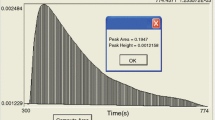Abstract
Four different glass compositions were used to encapsulate strontium chloroapatite (SrApCl) ceramics along with 10 mass/% simulated chloride waste to fabricate glass-bonded composites for nuclear waste immobilization applications. The glass compositions chosen were borosilicate glass (BSG), aluminoborosilicate glass (AlBSG), barium borosilicate glass (BaBSG) and lead borosilicate glass (PbBSG). The composites were fabricated by heat-treating the reaction mixtures at 1,073 K in air. The Products were characterised by powder XRD. The % linear thermal expansion of these composites was measured by dilatometry. The average thermal expansion coefficients (α av) of these composites were found to be in the range of 14.5 ± 0.29 × 10−6–16.4 ± 0.32 × 10−6 K−1 at 323–715 K range of measurement. The glass transition temperature (T g) of the glass–ceramic composites were also measured by dilatometry. T g and heat capacity (C p) of SrApCl-10w20BSG, SrApCl-10w20AlBSG, SrApCl-10w20BaBSG and SrApCl-10w20PbBSG were also measured by differential scanning calorimetry (DSC), and the values obtained are 730 ± 22, 718 ± 21, 700 ± 20 and 700 ± 20 K, respectively. The C p values for SrApCl-10w20BSG, SrApCl-10w20AlBSG, SrApCl-10w20BaBSG and SrApCl-10w20PbBSG are 0.57 ± 0.006, 0.60 ± 0.006, 0.52 ± 0.005 and 0.54 ± 0.005 J K−1 g−1, respectively.





Similar content being viewed by others
References
Chang YI. The integral fast reactor. Nucl Technol. 1989;88:129–38.
Chang YI. Technical rationale for metal fuel in fast reactors. Nucl Eng Technol. 2007;39(3):161–70.
Till CE, Chang YI. Progress and status of the integral fast reactors (IFR): fuel cycle development. Argonne National Laboratory. 1991: ANL/CP-72650.
Priebe S. The ceramic waste form process at Idaho National Laboratory. International conference on incineration and thermal treatment technologies. 2007: INL/CON-07-12580.
Pereira C. Production of sodalite waste forms by addition of glass. Argonne National Laboratory. 1995: ANL/CMT/CP-84675.
Thomson KT, Wentzcovitch RM. A density functional study of the electronic structure of sodalite. J Chem Phys. 1998;108(20):8584–8.
Trocellier P. Immobilization of radionuclides in single phase crystalline waste forms: a review on their intrinsic properties and long term behavior. Ann Chim Sci Mat. 2000;25:321–37.
Wei M, Evans JH, Bostrom T, Grondhal L. Synthesis and characterization of hydroxyapatite, fluoride-substituted hydroxyapatite and fluorapatite. J Mater Sci Mater Med. 2003;14:311–20.
Jena H, Krishnan RV, Asuvathraman R, Nagarajan K, Kutty KVG. Thermal expansion and heat capacity measurements on Ba10−xCsx(PO4)6Cl2−δ, (x = 0, 0.5) chloroapatites synthesized by sonochemical process. J Therm Anal Calorim. 2011;106:875–9.
Krishnan RV, Jena H, Kutty KVG, Nagarajan K. Heat capacity of Sr10(PO4)6Cl2 and Ca10(PO4)6Cl2 by DSC. Theremochim Acta. 2008;478:13–6.
Nriagu JO. Lead orthophosphates-IV: formation and stability in the environment. Geochim Cosmochim Acta. 1974;38:887–98.
Donald IW, Metcalfe BL, Fong SK, Gerrard LA, Strachan DM, Scheele RD. A glass-encapsulated calcium phosphate waste form for the immobilization of actinide, fluoride-, and chloride-containing radioactive wastes from the pyrochemical reprocessing of plutonium metal. J Nucl Mater. 2007;361:78–93.
Jena H, Maji BK, Asuvathraman R, Kutty KVG. Synthesis and thermal characterization of glass bonded Ca-chloroapatite matrices for pyrochemical chloride waste immobilization. J Non-Cryst Solids. 2012;358:1681–6.
Uruga K, Sawada K, Arita Y, Enokida Y, Yamamoto I. Removal of platinum group metals contained in molten glass using copper. J Nucl Sci Tech. 2007;44(7):1024–31.
Lewis MA, Verma S, Ackerman JP. Effect of different glasses in glass-bonded zeolite. Argonne National Laboratory. 1995: ANL/CMT/CP-84676.
Chiba J. Barium borosilicate glass and glass-ceramic compostion. Patent number US6362119B1, March 26, 2002.
Kaushik CP, Mishra RK, Sengupta P, Kumar A, Das D, Kole GB, Raj K. Barium borosilicate glass—a potential matrix for immobilization of sulphate bearing high-level radioactive waste. J Nucl Mater. 2006;358:129–38.
Raj K, Prasad KK, Bansal NK. Radioactive waste management practices in India. Nucl Eng Des. 2006;236:914–30.
Kutty KVG, Asuvathraman R, Krishnaiah MV, Ganesan V, Parthasarathy R, Subalakshmi DS, Suhasini B, Srinivas KC, Gopal KA, Kumar PV. 2006: IGC report no 283.
Kaelble EF. MgO thermal expansion. In: Kaelble EF, editor. Handbook of X-rays. Chapter 13. New York: Mc-Graw Hill; 1967, p. 15.
Belle J, Berman RM. Thermal expansion chapter. In: Belle J, Berman RM, editors. Thorium dioxide: preparation and nuclear applications. DOE/NE-0060, US Department of Energy, Washington D.C, Govt. printing office, USA, 1984. p. 169.
Ho CY, Taylor RE (editors). Thermal expansion of solids, ASM International: Materials Park; 1998. Chapter 1–2, pp. 1–131.
Czichos H, Saito T, Smith E (editors). Thermal expansion. In: Springer handbook of materials measurement methods, 2006. Chapter-2, p. 415.
Jena H, Asuvathraman R, Kutty KVG, Rao PRV. Comparison of electrical conductivity and thermal properties of borosilicate glass with and without simulated radioactive waste. J Therm Anal Calorim. 2014;115:367–74.
Avramov I, Vassilev Ts, Penkov I. The glass transition temperature of silicate and borate glasses. J Non-Cryst Solids. 2005;351:472–6.
Acknowledgements
The authors are very much thankful to Dr. P. R. Vasudeva Rao, Director Chemistry Group and Director IGCAR for his support and constant encouragement. The authors thank Mr. Abhiram Senapati for recording the DSC data on these samples.
Author information
Authors and Affiliations
Corresponding author
Rights and permissions
About this article
Cite this article
Maji, B.K., Jena, H., Krishnan, R.V. et al. Comparison of thermal expansion and heat capacity properties of various borosilicate glass-bonded strontium chloroapatite composites loaded with simulated pyrochemical waste. J Therm Anal Calorim 119, 1825–1831 (2015). https://doi.org/10.1007/s10973-014-4322-1
Received:
Accepted:
Published:
Issue Date:
DOI: https://doi.org/10.1007/s10973-014-4322-1




